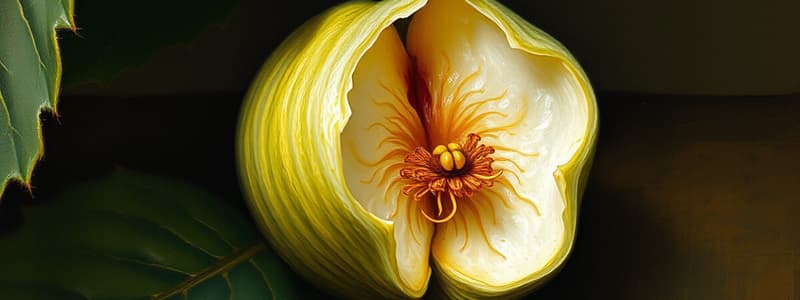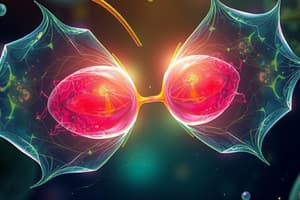Podcast
Questions and Answers
What is the primary role of fruit in plant reproduction?
What is the primary role of fruit in plant reproduction?
- To provide nutrients for the root system
- To increase the seed size
- To enhance seed germination
- To protect the seed and facilitate dispersal (correct)
In which type of plant seed is food primarily stored in the cotyledons?
In which type of plant seed is food primarily stored in the cotyledons?
- Endospermic seeds
- Non-endospermic seeds (correct)
- Monocot seeds
- Asexual seeds
What is the first part of the new plant to emerge from the seed during germination?
What is the first part of the new plant to emerge from the seed during germination?
- Radicle (correct)
- Cotyledon
- Plumule
- Testa
Which statement accurately describes seed dormancy?
Which statement accurately describes seed dormancy?
What mechanism is used to produce seedless fruit?
What mechanism is used to produce seedless fruit?
Which structure in the seed develops into the shoot?
Which structure in the seed develops into the shoot?
Which type of seed has its food stored primarily in the endosperm?
Which type of seed has its food stored primarily in the endosperm?
What is the primary purpose of petals in flowers?
What is the primary purpose of petals in flowers?
Which part of the flower is responsible for producing pollen?
Which part of the flower is responsible for producing pollen?
What occurs first in the formation of female gametes in plants?
What occurs first in the formation of female gametes in plants?
What is the role of the style in the female part of a flower?
What is the role of the style in the female part of a flower?
Which of the following describes the ovary in the carpel?
Which of the following describes the ovary in the carpel?
What type of nuclei are found in the embryo sac?
What type of nuclei are found in the embryo sac?
What effect does the receptacle have on the flower?
What effect does the receptacle have on the flower?
During which stage do the majority of megaspores degenerate?
During which stage do the majority of megaspores degenerate?
How are male gametes formed in plants?
How are male gametes formed in plants?
What is the function of the nectary in a flower?
What is the function of the nectary in a flower?
What is the role of the tube nucleus during pollen tube growth?
What is the role of the tube nucleus during pollen tube growth?
Which type of pollination leads to less genetic variation in plants?
Which type of pollination leads to less genetic variation in plants?
How does the generative nucleus contribute to fertilization?
How does the generative nucleus contribute to fertilization?
What causes the pollen tube to navigate towards the ovule?
What causes the pollen tube to navigate towards the ovule?
What is formed when one male gamete fuses with the polar nuclei?
What is formed when one male gamete fuses with the polar nuclei?
Flashcards are hidden until you start studying
Study Notes
Double Fertilisation and Seed Formation
- Ovule swells and wall toughens to form the seed coat (testa) post-fertilisation.
- Zygote develops into the embryo of the seed.
- Triploid endosperm nucleus rapidly divides, creating food storage tissue.
- Integuments thicken, forming the protective testa.
- Seeds become dormant once formed and dried.
Seed Structure
- Embryo: Develops into the new plant.
- Testa: Tough seed coat protects the seed during dormancy.
- Radicle: First part to emerge, becoming the root.
- Plumule: Emerges after the radicle, developing into the shoot.
- Cotyledons: Seed leaves containing food reserves; mono (one) vs. di (two) cotyledons.
- In monocots (e.g., maize, wheat), food is stored in the endosperm.
- In dicots (e.g., broad bean), food is stored in the cotyledons.
Fruit Formation
- Fruits protect seeds and facilitate seed dispersal.
- Seedless fruits, such as watermelons, are produced through genetic selection or asexual propagation.
Plant Reproduction Overview
- Sexual reproduction involves gamete fertilisation; asexual reproduction does not involve gametes.
- Flowers are essential for sexual reproduction in plants.
Functions of Flower Parts
- Sepals: Protect and enclose the flower before blooming, sometimes closing at night.
- Petals: Brightly colored to attract pollinators, producing scent for insects.
- Stamens: Male parts consisting of anther (produces pollen) and filament (supports anther).
- Carpel: Female part consisting of stigma (catches pollen), style (connects stigma to ovary), and ovary (contains ovules).
- Receptacle: Thickened pedicel part where flower parts grow.
- Nectary: Produces nectar at the base of petals.
Gamete Development
- Female gametes arise in the ovule; a diploid megaspore mother cell undergoes meiosis.
- Surviving megaspore divides to form an embryo sac with 8 nuclei: 2 polar nuclei and an egg cell.
- Male gametes develop in the anther from diploid microspore mother cells via meiosis, resulting in four haploid microspores.
- Microspores divide to form pollen grains, consisting of tube nucleus (guides pollen tube) and generative nucleus (forms male gametes).
Pollination Types
- Pollination: Transfer of pollen from an anther to a stigma.
- Self-pollination: Occurs within the same plant, reducing genetic variation.
- Cross-pollination: Involves different plants, promoting genetic diversity.
Pollination Methods
- Insect Pollination: Bees gather nectar and pollen, transferring pollen between flowers.
- Wind Pollination: Plants like wheat produce light pollen that disperses easily in the wind.
Fertilisation Process
- Fusion of male and female gametes results in the diploid zygote.
- Pollen grain germinates on stigma, forming a pollen tube that grows toward the ovule.
- As the pollen tube grows, the generative nucleus divides to produce two sperm nuclei.
- One sperm nucleus fuses with the egg cell to form the zygote; the other fuses with polar nuclei to form the triploid endosperm.
Studying That Suits You
Use AI to generate personalized quizzes and flashcards to suit your learning preferences.




